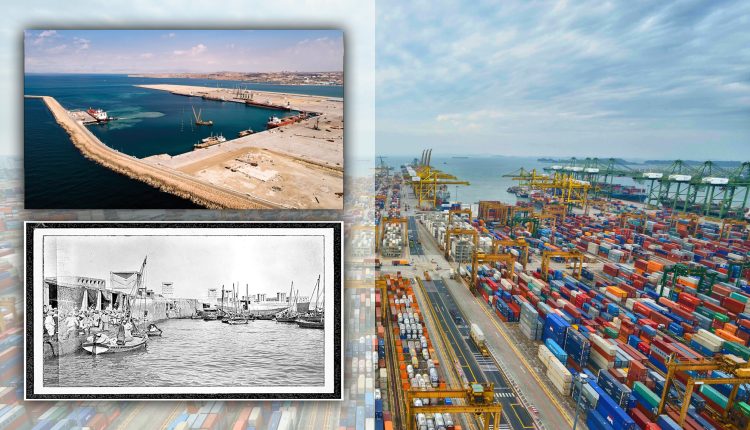Iranian Ports in the Shadow of History, Singapore Ports in the Light of Progress
From Singapore to Iran: Lessons for Maritime Economy Advancement
SEA News – Analysis: Iran has historically played a significant role in regional and global trade with its several-thousand-year-old maritime industry. The world’s first naval fleet was launched under the command of Cyrus the Great during the Achaemenid period (559-330 BCE). During the Sassanian era (224-651 CE) and early Islam, Siraf port was known as one of the most important commercial centers in the Persian Gulf. In the Qajar period (1789-1925 CE), Bushehr port developed as a significant commercial and military port, and during the Safavid era (1501-1736 CE), Bandar Abbas expanded as a strategic port, changing its name from “Gombroon” to “Bandar Abbas.”
However, despite this rich history and millennia of experience, what weight and position do Iranian ports hold compared to regional and global counterparts? Are our ports in desirable conditions? Even after thousands of years, we have not reached the level of development seen in advanced ports like Singapore. Since the early 1960s, Singapore, through extensive infrastructure investment, advanced technologies, and efficient management, has transformed into one of the busiest and most efficient ports globally. Singapore began its fundamental changes in port and economic development following its independence in 1965. Throughout the 1970s and 1980s, the country actively invested in port infrastructure, advanced technologies, and efficient management, a trend that continues to this day.
Singapore has long been recognized as a premier maritime capital. Implementing appropriate trade policies and positioning itself between Asia and Europe has placed Singapore in a position that was unimaginable forty years ago. Singapore has achieved these successes over decades, while Iran, despite its long history in this field, finds itself in an unfavorable position today. This report examines the actions and policies that could bring Iranian ports closer to the level of advanced ports worldwide, a goal not reflected in our current port developments.
**Comparative Analysis of Iranian and Singaporean Ports**
**Strategic Geographical Position**
Both Iran and Singapore enjoy strategic geographical positions. Iranian ports in the Persian Gulf and the Sea of Oman like Bandar Abbas and Chabahar, and Singapore port in the Strait of Malacca, play a key geopolitical role in global trade. These locations provide access to large regional markets and have significant development potential.
**Investment in Infrastructure**
Singapore’s port has become one of the busiest globally through massive investment in port and logistics infrastructure, including modern docks, advanced loading equipment, and large container terminals. In contrast, many Iranian ports still require development and modernization of infrastructure.
**Utilization of Advanced Technologies**
Singapore has significantly increased its efficiency by employing smart port management systems, process automation, robotics, and digitalization. Iran, on the other hand, has limited use of these technologies, resulting in reduced efficiency and increased loading and unloading times.
**Efficient and Professional Management**
Professional and efficient management using international best practices and high standards is among the key success factors for Singapore’s port. Iran also needs improvement in management and implementation of international standards in its ports.
**Facilitation of Trade and Customs Regulations**
Simple and transparent trade and customs regulations in Singapore have facilitated and expedited business processes. Complex and inefficient regulations in Iran have caused delays and reduced attractiveness for foreign investors.
**Attracting Foreign Investment**
Singapore has created an attractive environment for foreign investment through incentives and tax benefits. Conversely, sanctions and economic instability in Iran have hindered sufficient foreign investment.
**Attention to Environmental Sustainability**
Singapore plays a significant role in environmental protection through sustainable projects and the use of renewable energy. Iran has shown limited attention to environmental issues and less use of renewable energy in port operations.
**Recommendations for Improving Iran’s Port Situation**
Iran needs extensive foreign investment for the improvement and modernization of port infrastructure and equipment. This includes building and improving container terminals, docks, warehouses, and loading/unloading equipment.
Utilizing advanced technologies and process automation to increase efficiency and reduce operation times in Iranian ports is essential.
Facilitation, transparency, and revision of trade and customs laws to attract investment and facilitate trade should be a priority.
Training employees and utilizing skilled workforce and professional management can improve the efficiency of Iranian ports.
Offering financial incentives for foreign investment and cooperation with advanced world ports should be considered.
Privatization of port management and terminals can increase efficiency and competitiveness through private sector involvement.
Iranian ports, with their strategic geographical position and rich natural resources, have great potential to become important hubs for international trade. However, to reach the level of advanced ports like Singapore, extensive investment in infrastructure, adoption of advanced technologies, improved management and trade regulations, attracting foreign investment, and attention to environmental issues are necessary. Despite considerable efforts and domestic investments, other factors such as threats and hardships resulting from unfair sanctions have prevented desired outcomes.
**Sources**
– Herodotus Histories, Book 3
– Historical articles on the Achaemenid Empire
– “History of Persian Gulf Ports” by Abdolnabi Ghaem
– “Bushehr Through Time” by Naser Najmi
– “Iran in the Safavid Era” by Roger Savory
– “History of Singapore” by C.M. Turnbull

